程序清单7.6
#include<iostream> using namespace std; const int Size = 8; int sum_arr(int arr[], int n);//函数声明 void main() { int cookies[Size] = { 1,2,4,8,16,32,64,128 }; cout << cookies << " =array address," << sizeof cookies << " =sizeof cookies" << endl; int sum = sum_arr(cookies, Size); cout << "Total cookies eaten: " << sum << endl; sum = sum_arr(cookies, 3); cout << "First three eaters ate " << sum << endl; sum = sum_arr(cookies+4,4); cout << "Last four eaters ate " << sum << endl; system("pause"); } int sum_arr(int arr[], int n)//输出地址,大小,计算和 { int total = 0; cout << arr << " =arr," << sizeof(arr) << " =sizeof(arr)" << endl; for (int i = 0; i <n; i++) total += arr[i]; return total; }

指针和const
const的位置不同,指针可以进行的操作也不同


month数组被const修饰了,所以如果要使用sum函数的话,需要修改第四行代码
int sum(const int arr[],int n)
函数和二维数组
先修知识:指针数组和数组指针
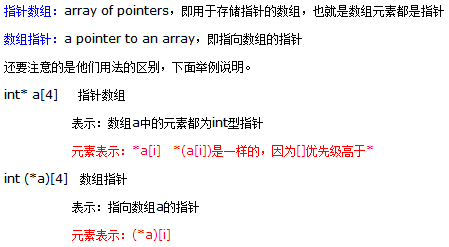
#include <iostream> using namespace std; int main() { int c[4] = { 1,2,3,4 }; int *a[4]; //指针数组 int(*b)[4]; //数组指针 b = &c; for (int i = 0; i<4; i++)//将数组c中元素赋给数组a { a[i] = &c[i]; } cout << *a[1] << endl; //输出2就对 cout << (*b)[2] << endl; //输出3就对 return 0; }
OK,进入正题,函数与二维数组
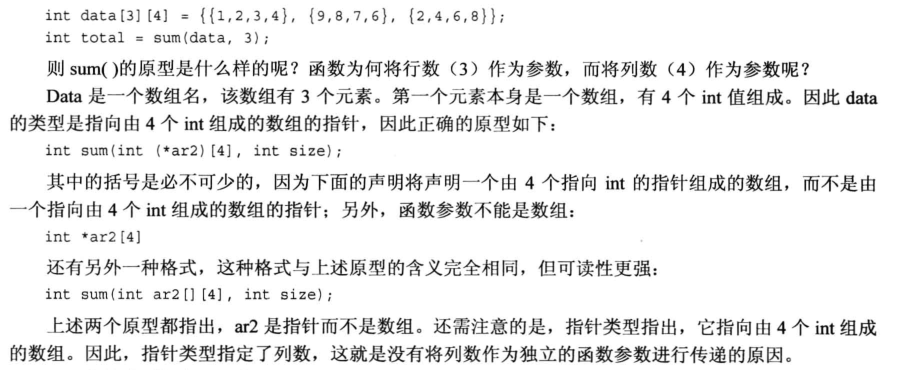
#include<iostream> using namespace std; //数组表示法 int sum(int arr[][4], int n) { int total = 0; for (int r = 0; r < n; r++) { for (int c = 0; c < 4; c++) { cout << arr[r][c] << " "; total += arr[r][c]; } cout << endl; } return total; } //指针表示法 int sum2(int (*arr)[4],int n)//数组指针:指向数组的指针 { int total = 0; for (int r = 0; r < n; r++) { for (int c = 0; c < 4; c++) { cout << *(*(arr+r)+c)<< " ";//arr是一个指向数组(4个int整数)的指针,*(arr+r)=arr[r]表示指向第(r+1)个数组 total += *(*(arr + r) + c); } cout << endl; } return total; } void main() { int data[3][4] = { {1,2,3,4},{5,6,7,8},{9,10,11,12} }; int s = sum(data, 3); cout << s << endl; getchar(); }

程序清单7.11
#include<iostream> using namespace std; const int Rate = 60; struct time { int hour; int mins; }; time sum(time a, time b) { time total; total.hour = a.hour + b.hour + (a.mins + b.mins) / Rate; total.mins = (a.mins + b.mins) % 60; return total; } void show(time t) { cout << t.hour << " hours," << t.mins << " minutes." << endl; } void main() { time d1 = { 5,45 }; time d2 = { 4,55 }; time trip = sum(d1, d2); cout << "Two_day total:"; show(trip); time d3 = { 4,32 }; cout << "Three_day total:"; show(sum(trip, d3)); getchar(); }

程序清单7.12+7.13
#include<iostream> #include<cmath> using namespace std; struct polar{ double distance; double angle; }; struct rect { double x; double y; }; void rect_to_polar(const rect *pxy, polar *pda) {//由于形参是指针而不是结构,所以只能用箭头操作符而不能用点操作符 pda->distance = sqrt( pxy->x*pxy->x + pxy->y*pxy->y ); pda->angle = atan2(pxy->y, pxy->x); } void show(const polar *pda) { const double Rate = 57.29577951; cout << "distance=" << pda->distance; cout << ",angle=" << pda->angle*Rate<<" degrees"<<endl; } void main() { rect r; polar p; cout << "Enter the x and y value:"; while (cin>>r.x>>r.y) { rect_to_polar(&r, &p); show(&p); cout << "Next 2 numbers(q to quit):"; } cout << "Done." << endl; getchar(); }

程序清单7.14(string对象数组)
#include<iostream> #include<string> using namespace std; const int Size = 5; void display(const string s[],int n) { for (int i = 0; i < n; i++) cout << i+1 <<": "<<s[i]<<endl; } void main() { string list[Size]; cout << "Enter your " << Size << " favorite XX" << endl; for (int i = 0; i < Size; i++) { cout << i + 1 << ": "; getline(cin, list[i]);//读取string对象 } cout << "Your list:" << endl; display(list, Size); system("pause"); }

程序清单7.15(array对象)
#include<iostream> #include<string> #include<array> using namespace std; const array<string, 4> Sname = { "Spring","Summer","Fall","Winter" }; void fill(array<double, 4> *p) { for (int i = 0; i < 4; i++) { cout << "Enter " << Sname[i] << " expenses:"; cin >> (*p)[i];//p是地址,*p是array对象,(*p)[i]是array对象里的第(i+1)个double数据 } } void show(array<double, 4> q) { double sum = 0.0; cout << "EXPENSES" << endl; for (int i = 0; i < 4; i++) { cout << Sname[i] << ": $" << q[i] << endl; sum += q[i]; } cout << "Sum expenses: $" << sum << endl; } void main() { array<double, 4> expense; fill(&expense); show(expense); system("pause"); }
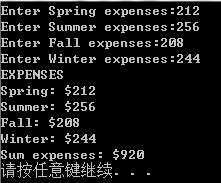
程序清单7.16,7.17(递归)
#include<iostream> using namespace std; void down(int n) { cout << "Counting down " << n <<", n at "<<&n<< endl; if (n > 0) down(n - 1); cout << n << ": Kaboom!" << " n at " << &n << endl; } void main() { down(4); system("pause"); }

#include<iostream> using namespace std; const int Len = 66; const int Div = 6; void subdivide(char ar[],int low,int high,int level) { if (level == 0) return; int mid = (high + low) / 2; ar[mid] = '|'; subdivide(ar, low, mid, level - 1); subdivide(ar, mid, high,level - 1); } void main() { char ruler[Len]; int i; for (i = 1; i < Len - 2; i++)//去掉一个头,两个尾 ruler[i] = ' '; ruler[Len - 1] = '�';//末尾设置为结束符 int max = Len - 2;//倒数第二位(去掉结束符后的末尾) int min = 0; ruler[min] = ruler[max] = '|'; cout << ruler << endl; for (i = 1; i <=Div; i++) { subdivide(ruler, min, max, i); cout << ruler << endl; } system("pause"); }

函数指针
double (*pf)(int);//pf是一个指向函数(函数返回double)的指针 double *pd(int);//pd()是一个返回double *的函数
函数声明
void aa(int n, double(*pf)(int));
指出,pf是一个函数指针,它指向的函数接受一个int参数,并返回一个double值。
aa(50,函数名) 即可进行调用。
程序清单7.18
#include<iostream> using namespace std; void estimate(int line,double (*pf)(int)) { cout << line << " lines will take "; cout << (*pf)(line) << " hour(s)." << endl; } double bet(int lns) { return 0.05*lns; } double pam(int lns) { return 0.03*lns + 0.0004*lns*lns;; } void main() { int code; cout << "How many lines? "; cin >> code; cout << "Here is Bet's estimate:" << endl; estimate(code, bet); cout << "Here is Pam's estimate:" << endl; estimate(code, pam); system("pause"); }
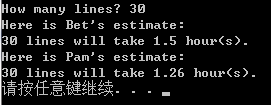
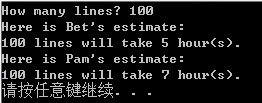
函数指针数组
const double * f1(const double ar[], int n); const double * f2(const double [], int); const double * f3(const double *, int);//这三行代码的含义完全相同 const double *(*pa[3])(const double *, int) = { f1,f2,f3 };//声明,并初始化 *pd[3] //an array of 3 pointers (*pd)[3] //a pointer to an array of 3 elements
程序清单7.19
1 #include<iostream> 2 using namespace std; 3 4 const double * f1(const double *ar, int n) { //f1()是一个返回double类型指针的函数 5 return ar;//返回的是地址,要得到值得话,必须加上*符号 6 } 7 const double * f2(const double ar[], int n) { 8 return ar + 1; 9 } 10 const double * f3(const double ar[], int n) { 11 return ar + 2; 12 } 13 14 void main() 15 { 16 double av[3] = { 1112.3,1542.6,2227.9 }; 17 const double *(*p1)(const double *, int) = f1;//p1是函数指针,指向f1函数的地址,*p1(即f1函数)传入double地址和int长度,返回double地址 18 auto p2 = f2; 19 cout << "Using pointers to functions:" << endl << "Address Value" << endl; 20 cout << (*p1)(av, 3) << ": " << *(*p1)(av, 3) << endl;//*p1表示函数,前者调用函数,返回double值得地址,后者为取出地址所代表的的double值 21 cout << p2(av, 3) << ": " << *p2(av, 3) << endl;//p2表示函数 22 23 const double *(*pa[3])(const double *, int) = { f1,f2,f3 };//声明一个函数指针数组 24 auto pb = pa;//pa表示函数指针数组的地址 25 cout << "Using an array of pointers to functions:" << endl << "Address Value" << endl; 26 for (int i = 0; i < 3; i++) 27 cout << pa[i](av, 3) << ": " << *pa[i](av, 3) << endl; 28 cout << "Using a pointer to a pointer to a functions:" << endl << "Address Value" << endl; 29 for (int i = 0; i < 3; i++) 30 cout << pb[i](av, 3) << ": " << *pb[i](av, 3) << endl; 31 32 cout << "Using pointers to an array of pointers :" << endl << "Address Value" << endl; 33 auto pc = &pa; 34 cout << (*pc)[0](av, 3) << ": " << *(*pc)[0](av, 3) << endl; 35 const double *(*(*pd)[3])(const double *, int) = &pa;//参见23行,pd表示pa的地址,所以在23行定义的基础上再多一个*号 36 const double * pdb = (*pd)[1](av, 3);//(*pd)=pa,pdb表示av[1]的地址 37 cout << pdb << ": " << *pdb << endl; 38 cout << (*(*pd)[2])(av, 3) << ": " << *(*(*pd)[2])(av, 3) << endl;//(*pd)=pa,(*(*pd)[2])=(*pa[2])表示函数指针数组的第三个指针元素 39 40 system("pause"); 41 }

